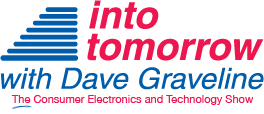Podcast: Play in new window | Embed
Tech News & Commentary
Karen in London, Tennessee calling in via the App asked us: “My mom has an iPad Mini that she takes on a lot of trips with her. Is there a way to hook up a USB to the charging port to be able to pull her pictures from for storage?”
Karen, What she needs is not a common product you can usually find in stores, but there are plenty of products you can use that can hook up to your charging port in order to use it as a USB drive.
We weren’t able to find any in local electronics stores like Best Buy, but online, Best Buy offers the lightning connector for about $20. Online, you’ll find similar products on different websites for as low as $3– so you definitely want to look around, although Best Buy’s product I just mentioned is actually manufactured by Apple, so you can’t go wrong with that! Also make sure you get the right connector, one that will fit both your charging port and the USB data cable you wish to use.
 If you are running iOS 7 or 8, however, you’re out of luck. Apple has locked down the USB port capability of their devices. There are no flash drives that will work with it. The Kingston Wi-Drive, a wireless USB drive, can be used with iOS 7 but not iOS 8.
If you are running iOS 7 or 8, however, you’re out of luck. Apple has locked down the USB port capability of their devices. There are no flash drives that will work with it. The Kingston Wi-Drive, a wireless USB drive, can be used with iOS 7 but not iOS 8.
Frankly, the right way to do this is with a cloud service such as iCloud Drive or Dropbox. You can easily upload all the pictures from the iPad Mini to the cloud, then delete them from the camera roll on the iPad. If you’re using Dropbox for this, you can then view the pictures using the Dropbox app without having to download them back to the iPad, assuming that you’re connected to the Internet of course.
For more information, tune in to Hour 3 of our podcast.
“Into Gaming Update” Weekly Feature with Mark Lautenschlager
Janet in Bristol, Connecticut listens online and is calling via the App asked us: “I’m looking to replace a 7 year old laptop. I’m wondering if I should replace it with another laptop or go with a tablet. I use it basically to check e-mail, surf the web and pay bills online. If you do recommend a tablet, which one would you recommend?”
Janet, For your purposes you could actually get away with a tablet!
Most people can’t fully replace a laptop with a tablet, but email and web surfing are typically good missions for a tablet.
Keep in mind that if you do get one rather than a laptop, some pages may not work the way they’re supposed to. You won’t have Flash, some pages may insist on sending you to the crippled mobile version when you’d rather see the full site, and some layouts may not translate properly.
You also have the option of looking into a Chromebook. They look like laptops, but really, they’re more like web browsers that come with a built in screen and keyboard more than they are full computers. You cannot install any programs, everything runs on the browser. The upside of that is that they’re always up to date with all security patches, and that they should work for what you need and never really require any maintenance from you.
If you know anyone that would let you borrow a full computer every now and then if you need it, a tablet may be a viable choice for you, but otherwise maybe a cheap laptop is a good alternative. You don’t need any real power to run a web browser and check email, so the cheapest laptop you can find will probably fulfill your needs just fine.
If you do get a tablet, you probably want to go for a decent one, if you’re going to have a it as your sole machine. Look into an iPad or a high end Android tablet, but try to stay away from the very cheap Android tablets, you probably won’t be satisfied with their performance.
The one thing to keep in mind about both tablets and Chromebooks is printing. To print from a laptop is a simple thing. You just select the print option from whatever program you’re running, choose a printer, and that’s it. To print from a tablet or Chromebook, it gets complicated.
With an iPad, the printer would need to support AirPrint. If you buy one that does, then it’s just as easy as printing from a computer. You touch the “Send to” icon, choose “Print,” and select the printer you want from the list that pops up.
Android tablets and Chromebooks work the same way if you have a printer supporting Google Cloud Print. If your printer does not have direct support for it, but you have a computer running Google’s Chrome browser that can print on that printer, you can activate Cloud Print support on that computer and send your printing through there.
See what we mean? It’s fiddly. Just don’t let it surprise you. Printing is the one thing people never think about with tablets or Chromebooks, but it’s an important consideration.
One new development has been very low cost Windows 8.1 computers that have hardware similar to Chromebooks (not quite as fast, about 20% slower) and include not only Windows 8.1 but also a one year subscription to Office 365 as part of the purchase price.
The HP Stream is one example. The 11” model with 32GB of SSD storage and 2GB of RAM sells for just $199. That’s Chromebook money. Yes, the hardware is a tad slower, but the trade off for that is you get the real, full Windows software and full Microsoft Office. Being able to run whatever Windows apps you have that will shoehorn in to that kind of modest hardware might be worth the slight decrease in browser speed.
And don’t forget, cheap Windows laptops can run Chrome, too.
For more information, tune in to Hour 3 of our podcast.
Guest Segment:
Joanne Black, Founder – No More Cold Calling
The Breakthrough System That Will Leave Your Competition in the Dust
“IFA History Feature” brought to you by Messe-Berlin
At the International Funkausstellung 1989, known worldwide as IFA, Thomson had a 10.000 square foot booth to demonstrate future technologies and presented there, the first prototype of a CD recorder named MOD, Magneto Optical Disc. With MOD, developed in Germany, for the first time it was possible to record on a CD, using phase shift technology. At the same IFA show, LaserVision video discs by Philips had their world premiere and were first introduced to the US soon after, as a test market.
Joseph in State College, Pennsylvania listens on WRSC 103.1 asked: “I’m interested in getting a tablet. I like to go online and order over the Internet and I also like to get information over the Internet. Can you give me the best price on a good model or the best model you think would be sufficient?”
Joseph, The Apple iPad Air 2 is a very good tablet which seems to be dominating the market lately and getting a lot of attention, but for the price of $499 for the 16GB base model, it can do some damage to your wallet. Rest assured though, there are many alternatives.
The Google Nexus 7 rings up around $200 to $229. Featuring a quad-core Qualcomm Snapdragon S4 Pro processor and 2GB of RAM, browsing and usage is quite fast. For someone that wants to get information and order online, the 7 inch tablet is an good size. It’s not too big, and not too small, just the right size for online purchasing. The Nexus 7 is currently running on Android Jelly Bean 4.3. Now, please know that Google is replacing the Nexus 7 and 10 tablets with the new Nexus 9, which is virtually a clone of the iPad Mini 3.
The Nexus 9 will use a 64-bit processor, like the iPad Mini 3, and has the same screen size (8.9 inches) and aspect ratio. It also sells for the same price, $399 for the 16GB base model. Like the iPads it’s also not expandable in terms of memory.
Speaking of the iPad Mini, Apple will sell you a choice of three. The original iPad Mini with its low resolution screen, 16GB models cost $249. The iPad Mini 2 with its Retina screen and faster processor is $299 for a 16GB model. And the new iPad Mini 3, which LACKS the very fast A8X processor the iPad Air 2 offers, is $399 for a 16GB base configuration. In fact, aside from a fingerprint sensor and some other minor tweaks, the iPad Mini 3 isn’t really any different from the Mini 2, and it costs $100 more. So I’ll bet you can guess which tablet we’d recommend to you out of the three, right?
The ASUS MemoPad HD 7 is one of the most affordable tablets on the market at the moment. It ranges between $150-$160. For the affordable price, it is an ideal tablet for someone that just wants a tablet to browse the internet.
We’ve been impressed with the new tablets using Intel processors. They seem to perform very well, and if you’re considering Android it might be worth looking for tablets using Intel Atom processors, you might also hear them called Intel “Bay Trail” processors.
Samsung shouldn’t be disregarded, either. Their tablets are quite good, but aren’t really less expensive than Apple’s. We like the Galaxy Tab Pro tablets very much, but unless you’re planning to expand its memory with a microSDHC card, it’s all really the same price as Apple.
Bottom line? For quality tablets, the prices…really don’t vary. Cheap tablets cut corners, somewhere.
For more information, tune in to Hour 3 of our podcast.
If you have any questions about any of this week’s show info, please email us here.
This Week’s Prizes for Our Listeners
SMS Audio: Street by 50 – Over-The-Ear Headphones and earbuds
Parellels:Parallels Desktop 10 Software allows you to run Windows on your Mac
Kanex: GoPower Battery Pack – Mobile battery pack with built-in stand for smartphones
Tylt: Several Charging cases and cables – for smartphones and tablets


